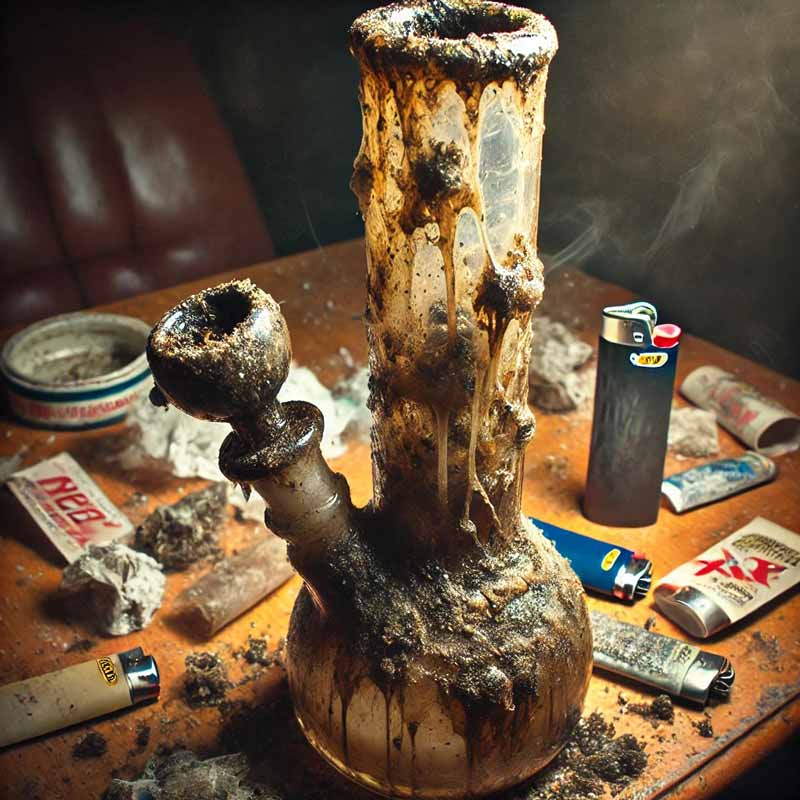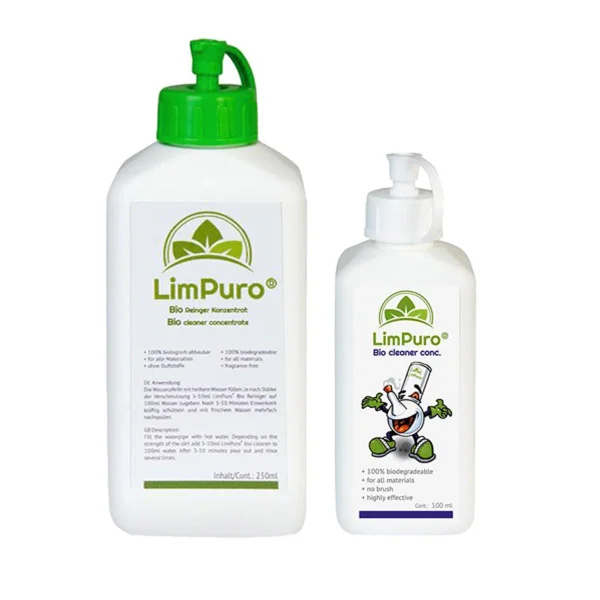Bong cleaning
Why is regular cleaning of the bong so important?
Better flavour and a much more pleasant smoking experience.
Residues of burnt material, resin and dirt build up over time and impair the flavour of the smoke. A freshly cleaned glass bong ensures a pure, unadulterated aroma and a much more pleasant and fresh smoking experience.Hygiene and health protection
Damp environments in the bong are an ideal breeding ground for bacteria, mould and other germs. Inhaling mould spores can be harmful to health and cause respiratory problems.Longer service life of the bong
Deposits can attack the material and damage glass Bongs in particular due to incrustation or tension. Regular cleaning prevents stubborn dirt from building up and making it difficult to remove.Visual aesthetics
A clean bong simply looks better and is more enjoyable to smoke. Glass Bongs in particular look unattractive over time when dark residue builds up.Easier cleaning with regular cleaning
The longer a bong is left uncleaned, the more difficult it is to remove old deposits. If you clean it regularly, you save yourself hours of time-consuming scrubbing.
The best methods for cleaning a bong
Classic method: alcohol and salt
Alcohol (preferably isopropanol 99% or ethanol) dissolves grease, resin and other residues particularly well and does not require any chemical substances. Salt, on the other hand, acts like an exfoliant and helps to remove stubborn dirt mechanically. A long exposure time is not necessary. Simply pour in, shake and you're done. The alcohol evaporates after use and leaves no unpleasant odours or flavours.Not suitable for Acrylic Bongs, as this can damage them.Natural cleaning: Vinegar and baking soda
Cleaning a bong with vinegar and baking soda is an environmentally friendly and harmless alternative to chemical cleaners. Both ingredients are biodegradable and contain no harsh chemicals, so no harmful vapours are produced. This makes them particularly suitable for people with sensitive respiratory tracts or anyone who favours natural cleaning methods.A major advantage of this method is the strong cleaning power of the chemical reaction between vinegar and baking soda. Vinegar acts as an acid that effectively dissolves limescale deposits and resin residues, while baking soda reacts with vinegar as an alkaline substance and forms a bubbly foam. This reaction not only dissolves stubborn dirt, but also neutralises unpleasant odours that have built up in the bong. Bong cleaning with vinegar and baking soda is also ideal for acrylic bongs.
Specialised bong cleaners: is it worth the investment?
The market offers a variety of special bong cleaners, such as Schmand Weg or Limpuro, which are often advertised as particularly effective and time-saving. But is the investment really worth it or are household remedies such as alcohol and salt or vinegar and baking soda just as good?
One clear advantage of specialised cleaners is their powerful cleaning formula. These products are specially designed to dissolve resin, tar and other residues in the shortest possible time - often without shaking or intensive scrubbing. Many contain active surfactants or enzymes that break down the deposits in a targeted manner, enabling particularly thorough cleaning. Another plus point is that some of these cleaners have odour-neutralising properties and provide a fresh fragrance. Caution: Not all cleaning agents for bongs are also suitable for acrylic. Please read the respective article descriptions carefully
Bong brushes
Of course, you also need a suitable brush for cleaning bongs. The range of bong brushes on offer differs primarily in terms of length (particularly important for large bongs) and the material of the brush head.- The brush should be long enough to easily reach the bong pipe or hose.
- The diameter must match the size of the bong - a brush that is too large will not reach everywhere and one that is too small will not clean effectively.
- Flexible brushes with bendable wire are suitable for narrow or curved areas.
- Special case percolator: Larger brushes are often pointless for pipes with swirlers. The main thing here is to extend the contact time. You can find out more about cleaning a percolator bong in our blog.
Material of the bristles
- Soft nylon or silicone bristles are ideal for delicate materials such as glass or acrylic, as they do not leave any scratches.
- Hard plastic or metalbristles can be useful for stubborn deposits, but should be used with caution on sensitive materials.
- Cleaning brushes with a woollen head are particularly gentle and gentle on the bong material.
How often should you clean your bong?
How often a bong should be cleaned depends on the frequency of use and the type of material used. Basically, the more regular the cleaning, the more pleasant the smoking experience and the easier the maintenance. If you use your bong daily or very frequently, you should clean it thoroughly at least every 1-2 days. If you use it occasionally, weekly cleaning is sufficient to avoid deposits and germs.How exactly do I go about cleaning it?
Dismantle the bong
- Remove all removable parts, such as the Chillum, the head and the percolator (if present).
- Rinse these parts briefly with warm water to remove any initial residue.
Remove coarse dirt
- Empty out the old bong water and rinse the bong with warm water.
- If deposits have already formed, you can soak the bong in warm water.
Choice of cleaning method
- Alcohol & salt: Effective against resin deposits, especially for glass bongs.
- Vinegar & baking soda: Environmentally friendly alternative, also suitable for acrylic bongs.
- Special bong cleaners: Fast and powerful, often gentle on the material.
Fill the bong with the cleaning solution
- Pour the selected cleaning solution into the bong.
- Close the openings (e.g. with a cork or rubber stopper) so that the liquid does not leak out.
Shake or leave to take effect
- Shake the bong vigorously so that the cleaning solution loosens all deposits.
- If necessary, leave the solution to work for 10-30 minutes to loosen stubborn dirt.
Cleaning individual parts
- Smaller parts such as the chillum or the head can be soaked in a separate container with the cleaning solution.
- Use brushes or pipe cleaners to thoroughly clean tight areas.
Rinse the bong thoroughly
- Rinse the bong and all individual parts several times with warm water until there are no more residues or odours.
- Make sure that no salt or cleaning agent residue remains in the bong.
Leave to dry
- Allow the bong and all parts to air dry completely before reassembling it.
- If you want to use the bong again quickly, you can dry it with a clean microfibre cloth or paper towels.
Reassembling the bong
- Put all the parts back in correctly and fill with fresh water.
- Check that everything is in place and the bong is ready for use.